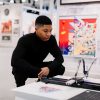IDOLS OF THE SUN is the latest series of sculptures from the internationally exhibited Israeli sculptor Dan Reisner – a deeply personal and never before seen series that channels his own PTSD to explore the collective trauma of conflict and propagate the cause of peace.
In 2000, Reisner suffered delayed post-traumatic stress disorder as a result of his army service as a combat medic in Lebanon in the 1980s, in which he treated multiple victims of conflict with profound life-changing injuries. The second Intifada, beginning in Israel in October 2000 – with over 6000 wounded, and 153 deaths in the first month – resurfaced deeply embedded trauma he had buried for over a decade.
Reisner turned this inner crisis and loss of faith in humanity to creativity, spending the next 25 years creating works of art that deep-dive into his lived experience as a soldier. Now, as the Middle East is once again gripped in conflict, the artist is ready to share with the world his most personal series of sculptures to date, in the hope of shining a timely light on human loss and the ultimate folly of war.
The ex-combat medic is already known internationally for his public art interventions, but it’s only now that he feels ready to reveal to the world his IDOLS OF THE SUN series, which consists of dozens of small bronze sculptures that refer to Reisner’s continual efforts to process and interpret the post-traumatic stress disorder he suffered following his time serving in the army, and shed light not only on the brutality inflicted on the bodies of the victims of war – presenting distorted, often faceless and sometimes otherworldly ‘self-portraits’ in various states of distress – but also on trauma as a catalyst for positive change. IDOLS OF THE SUN is thereby a cry for transformation like no other.
“I realised that if I didn’t take control of my healing, no one else could. I began to see my trauma, not just as something to survive, but something to create from. I realised that the images and feelings that plagued me could be transformed into tangible forms – into sculptures that allowed me to externalise the pain, fear, and chaos I was experiencing internally. This shift in perception was the beginning of my recovery. I started casting these insights, these very personal reckonings, into bronze, and from that process emerged a series of self-portraits.”
“Each piece represented a step in my healing, a release from the burden of trauma. In creating these works, I wasn’t just healing myself; I was contributing to the collective understanding of trauma, recovery, and the potential for transformation. Art became my tool for survival, self-expression, and ultimately, self-healing. I believe that art is a healing vehicle for all people. This is the reason we artists create art. It’s to inspire people to see that change can be made for the better. It’s our privilege and our commitment as artists.” – Dan Reisner
Never before revealed in their entirety IDOLS OF THE SUN prove deeply affecting, and represent the naked soul of the artist, who has never before fully shared his story, or the full gamut of these works, which represent the zenith of his talent.
“The process of making art allows for a deep internal release, a transformation of inner turmoil or joy into something tangible, something that can be shared with the world. Similarly, experiencing art can have a healing effect, offering moments of reflection, catharsis, and connection. It creates a space where the boundaries between self and other dissolve, and where we, as individuals, can experience our place within the broader collective. Art, in this way, becomes a tool for healing – not just personal healing, but healing on a societal or even global scale. It can reveal truths that words fail to capture, and it offers a form of therapy for our species, helping us to process our collective experiences, both the traumas and the triumphs, and find meaning in them. Now seems like the right moment to share them in their entirety.”
Other standout sculptures from Reisner’s 25-year career include The Murmur of the Seas (2013), marking the saving of 7000 Danish Jews in October 1943 who were sailed to safety by Danish people 70 years on, his Memorial Wall (2005) commemorating the lost lives of soldiers, and Auto-Portrait, an innovative 2015 sculpture made entirely of two scrapped cars. These sculptures make up a track record of over twenty permanent, large-scale sculptures around the world. In 2020 Floyd, Reisner’s striking sculpture of George Floyd in his final moments made headlines and was praised by Terrence Floyd, George Floyd’s brother. It went on to be one of the first art pieces acquired by the new International African American Museum, Charleston, South Carolina.
The landmark US museum, opened in 2023, was named as a TIME Magazine 2024 World’s Greatest Places pick, with iconic comedian Chris Rock undertaking the first museum tour. Ultimately, Reisner’s work unapologetically takes on the horrors and brutality of violence and war – both for himself, and through the eyes of global collective traumas.
“Art, for me, is about creating moments of connection, reflection, and sometimes healing. My own sculptures often emerge from personal struggles and the process of finding balance within myself. If my work can provide someone with a sense of release or offer them a moment of clarity, then it has fulfilled its purpose. I also hope my work reminds viewers of our shared human experience, of the connections we all share – our common joys, struggles, and growth. Art has the power to make us feel less alone, and if my sculptures can offer even a small sense of that connection, then I feel they have truly done their job. Art serves as a bridge to deeper understanding.”


